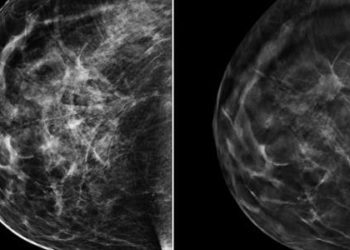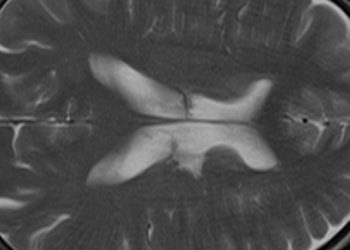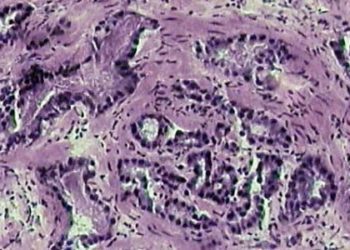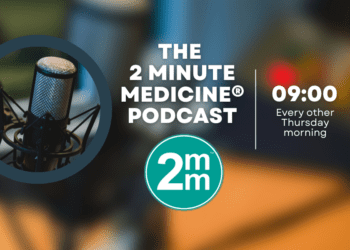Chemical shift and gadolinium-enhanced MRI identifies adrenal adenomas with high specificity and acceptable sensitivity [Classics Series]
This study summary is an excerpt from the book 2 Minute Medicine’s The Classics in Medicine: Summaries of the Landmark Trials
1. The relative change in mass-liver signal intensity (SI) ratio on opposed-phase versus in-phase magnetic resonance (MR) imaging was highly specific and sensitive in characterizing adrenal masses as adenomas.
2. Adenomas and nonadenomas could not be effectively differentiated with maximum SI after contrast administration or maximum washout.
Original Date of Publication: November 1995
Study Rundown: Adrenal masses are common incidental findings seen on computed tomography and encompass a spectrum of benign and malignant causes. For patients with extra-adrenal primary malignancy, deciphering the nature of concurrent adrenal lesions is critical given that the adrenal glands are in some instances the only site of metastatic disease. In attempting to differentiate adenomas from malignant adrenal masses using MR, the SI ratio of the adrenal mass to liver or fat on T1-weighted (T1W) and T2-weighted (T2W) spin-echo images generated with low- and medium-field strength magnets was initially proposed. However, with significant overlap in ratios for adenomas and nonadenomas, this MR technique proved to be of limited use in identifying malignant adrenal masses. This was until Mitchell and colleagues established that lipid-sensitive chemical shift techniques could be used to identify adrenal adenomas. This was on the basis that benign adrenocortical masses often contain high lipid content, while metastases and pheochromocytomas do not. Adenomas and nonadenomas also have different patterns of gadolinium enhancement on fast gradient-echo (GRE) images. The present study by Korobkin and colleagues evaluated the use of chemical shift and dynamic gadolinium-enhanced MR imaging in characterizing adrenal masses. Definitive diagnoses were made on the basis of other clinical imaging and pathologic criteria. The results of this study found that a decrease in the relative SI ratio on opposed-phase chemical shift images could be used to identify adenomas with high specificity and acceptable sensitivity. Visual assessment of adrenal masses with maximum SI after gadolinium enhancement did not allow for effective differentiation between adenomas and nonadenomas, and did not improve with washout.
Click to read the study in Radiology
In-Depth [prospective cohort]: Patients with adrenal masses detected through abdominal CT were consecutively enrolled into this study and further evaluated with chemical shift MR imaging, dynamic gadolinium-enhanced MR imaging, or both. Adrenal masses were assessed and defined as either adenomas or nonadenomas on the basis of other non-MR imaging and pathologic criteria. This included NP-59 scintigraphy, which was used to evaluate clinically suspected hyperfunctioning adenomas and some suspected non-hyperfunctioning adenomas. Percutaneous biopsy was performed when the adrenal mass was the only suspected metastatic site from an extra-adrenal primary neoplasm. Quantitative and qualitative review of the MR images was performed, assessing mass-liver SI ratios for T1W and T2W images. The relative change in mass-liver and mass-paraspinal muscle SI ratios on opposed-phase versus in-phase GRE imaging, the relative change in mass-liver SI ratio on fat-saturated T1W versus conventional T1W imaging, and the maximum SI of adrenal masses on gadolinium-enhanced images were also compared to unenhanced images. Comparing SI at maximum enhancement to that on the final 10-minute image allowed for the assessment of maximum gadolinium washout for each evaluated mass. Qualitative review was conducted using a 5-point scale and carried out by 2 investigators blinded to the clinical history and results of previous non-MR imaging. A single investigator blinded to the clinical data and qualitative results was responsible for quantitative review.
A total of 43 patients with 51 adrenal masses participated in this study. Of the 51 adrenal masses evaluated, 35 (n=28, mean age 57 years, range 35-78 years) were diagnosed as adenomas using non-MR imaging and/or pathology. The remaining 16 masses (n=15, mean age 51 years, range 19-72) were diagnosed as nonadenomas. Based on the results of qualitative review comparing adenomas and nonadenomas, the relative change in mass-liver ratio SI on opposed-phase versus in-phase GRE images was able to characterize adenomas with 100% specificity and 81% sensitivity. Adenomas were also identified with 100% specificity using the relative change in mass-muscle SI ratio on opposed-phase versus in-phase images (77% sensitivity) and the relative change in mass-liver SI ratio on fat-saturated T1W versus conventional T1W images (30% sensitivity). However, the maximum SI of an adrenal mass after contrast administration and following maximum contrast washout were of little to no diagnostic value, with 100% overlap in SI for adenomas and nonadenomas.
Korobkin M, Lombardi TJ, Aisen AM, Francis IR, Quint LE, Dunnick NR, Londy F, Shapiro B, Gross MD, Thompson NW. Characterization of adrenal masses with chemical shift and gadolinium-enhanced MR imaging. Radiology. 1995 Nov;197(2):411-8.
Additional Review:
Mitchell DG, Crovello M, Matteucci T, Petersen RO, Miettinen MM. Benign adrenocortical masses: diagnosis with chemical shift MR imaging. Radiology. 1992 Nov;185(2):345-51.
©2022 2 Minute Medicine, Inc. All rights reserved. No works may be reproduced without expressed written consent from 2 Minute Medicine, Inc. Inquire about licensing here. No article should be construed as medical advice and is not intended as such by the authors or by 2 Minute Medicine, Inc.







![The ABCD2 score: Risk of stroke after Transient Ischemic Attack (TIA) [Classics Series]](https://www.2minutemedicine.com/wp-content/uploads/2013/05/web-cover-classics-with-logo-medicine-BW-small-jpg-75x75.jpg)